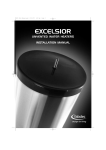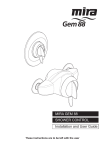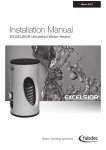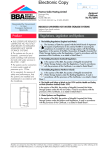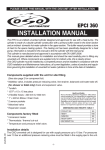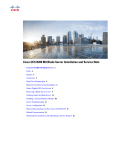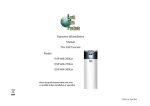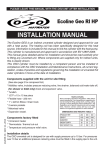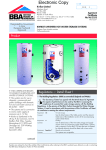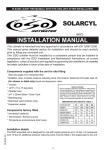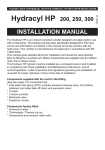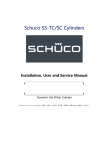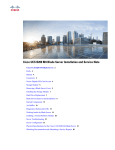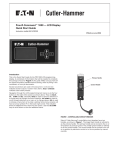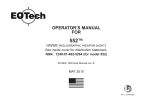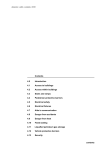Download Fabdec Limited FABDEC UNVENTED HOT WATER
Transcript
APPROVAL INSPECTION TESTING CERTIFICATION Fabdec Limited Grange Road Ellesmere Shropshire SY12 9DG Tel: 01691 627200 Fax: 01691 627222 TECHNICAL APPROVALS FOR CONSTRUCTION Agrément Certificate 09/4701 e-mail: [email protected] website: www.fabdec.com Product Sheet 1 FABDEC UNVENTED HOT WATER STORAGE SYSTEMS FABDEC DIRECT AND INDIRECT UNVENTED HOT WATER STORAGE SYSTEMS WITH INTEGRAL EXPANSION (2 BAR) This Agrément Certificate Product Sheet(1) relates to Fabdec Direct and Indirect Unvented Hot Water Storage Systems with Integral Expansion (2 bar), a range of polyurethane insulated stainless steel storage vessels for use with gas, electric or oil fired boilers on mains or other suitable potable water supply pressures up to and including 9 bar. (1) Hereinafter referred to as ‘Certificate’. CERTIFICATION INCLUDES: • factors relating to compliance with Building Regulations where applicable • factors relating to additional non-regulatory information where applicable • independently verified technical specification • assessment criteria and technical investigations • design considerations • installation guidance • regular surveillance of production • formal three-yearly review. KEY FACTORS ASSESSED Hot water storage and supply — the capacities of the systems range are comparable with conventional systems (see section 6). Safety — the system incorporates safety devices to safeguard the operation of the system (see section 7). Watertightness — the storage cylinder remains watertight at pressures in excess of 1.5 times the design pressure (see section 10). Durability — the systems are manufactured from durable materials and conventional plumbing components and will have a life equal to that expected of a vented system (see section 15). The BBA has awarded this Certificate to the company named above for the systems described herein. These systems have been assessed by the BBA as being fit for their intended use provided they are installed, used and maintained as set out in this Certificate. On behalf of the British Board of Agrément Date of First issue: 3 May 2013 Brian Chamberlain Greg Cooper Originally certificated on 4 December 2009. Head of Approvals — Engineering Chief Executive The BBA is a UKAS accredited certification body — Number 113. The schedule of the current scope of accreditation for product certification is available in pdf format via the UKAS link on the BBA website at www.bbacerts.co.uk Readers are advised to check the validity and latest issue number of this Agrément Certificate by either referring to the BBA website or contacting the BBA direct. British Board of Agrément Bucknalls Lane Watford Herts WD25 9BA ©2013 Page 1 of 15 tel: 01923 665300 fax: 01923 665301 e-mail: [email protected] website: www.bbacerts.co.uk Regulations In the opinion of the BBA, Fabdec Direct and Indirect Unvented Hot Water Storage Systems with Integral Expansion (2 bar), if installed, used and maintained in accordance with this Certificate, will meet or contribute to meeting the relevant requirements of the following Building Regulations (the presence of a UK map indicates that the subject is related to the Building Regulations in the region or regions of the UK depicted): The Building Regulations 2010 (England and Wales) (as amended) Requirement: G3 Hot water storage Comment: The systems incorporate suitable safety devices to meet the requirements of this Requirement. See sections 7 and 16 of this Certificate. Requirement: L1A/L1B Regulation 26 Conservation of fuel and power CO2 emission rates for new buildings Comment: The systems have acceptable standing energy losses, have adequate temperature controls and are supplied with detailed user instructions with maintenance requirements. See section 6 of this Certificate. Regulation 7 Materials and workmanship The systems are acceptable. See section 15 and the Installation part of this Certificate. Comment: The Building (Scotland) Regulations 2004 (as amended) Regulation: 8(1)(2) The systems comply with the requirements of this Regulation. See sections 14 and 15 and the Installation part of this Certificate. Comment: Regulation: Standard: 9 4.9 6.3 6.4 Insulation of pipes, ducts and vessels The storage vessels have adequate insulation and can satisfy this Standard, with reference to clause 6.4.2(1)(2). See section 6 of this Certificate. Comment: Standard: Heating system The systems are fitted with a thermostat which meets the requirements of this Standard, with reference to clauses 6.3.9(1) and 6.3.8(2). See section 6 of this Certificate. Comment: Standard: Building standards applicable to construction Danger from heat The systems are constructed to prevent the temperature of the stored water at any time exceeding 100°C and to provide adequate protection from malfunction of the system. The systems will satisfy this Standard, with reference to clauses 4.9.1(1)(2), 4.9.2(1)(2), 4.9.3(1)(2) and 4.9.4(1)(2). See sections 7 and 16 of this Certificate. Comment: Standard: Fitness and durability of materials and workmanship 7.1(a)(b) Statement of sustainability The product can contribute to meeting the relevant requirements of Regulation 9, Standards 1 to 6 and therefore will contribute to a construction meeting a bronze level of sustainability as defined in this Standard. Comment: (1) Technical Handbook (Domestic). (2) Technical Handbook (Non-Domestic). The Building Regulations (Northern Ireland) 2012 Regulation: 23(a)(i)(iii)(b) Fitness of materials and workmanship Comment: Regulation: Regulation: 39(a)(ii)(b)(c) 40 Conservation measures Target carbon dioxide Emissions Rate The systems are acceptable. See section 15 and the Installation part of this Certificate. The systems comply with the domestic heating compliance guide and, therefore, will satisfy the requirement of these Regulations. See section 6 of this Certificate. Comment: Regulation: Comment: 88 Unvented hot water storage systems The systems incorporate suitable safety devices to meet the requirements of this Regulation. See sections 7 and 16 of this Certificate. The Health and Safety at Work etc Act 1974 and the Health and Safety at Work (Northern Ireland) Order 1978 In buildings subject to this Act and Order, regular maintenance is a requirement (See section 14 of this Certificate). Water Supply (Water Fittings) Regulations 1999 England and Wales, Water Byelaws 2000, Scotland and the Water Regulations, Northern Ireland England and Wales In the opinion of the BBA, Fabdec Unvented Hot Water Storage Systems satisfy the requirements of the water Regulations if used and installed in accordance with this Certificate. Scotland In the opinion of the BBA, Fabdec Unvented Hot Water Storage Systems satisfy the requirements of the water Byelaws if used and installed in accordance with this Certificate. Page 2 of 15 Northern Ireland In the opinion of the BBA, Fabdec Unvented Hot Water Storage Systems satisfy the requirements of the Water Regulations if used and installed in accordance with this Certificate. The Electrical Equipment (Safety) Regulations 1994 and the Electromagnetic Compatibility Regulations 2005 These Regulations implement the Low Voltage Directive 73/23/EEC (as amended by the CE Marking Directive 93/68/EEC) and the Electromagnetic Compatibility Directive 89/336/EEC and require manufacturers to carry out assessment of their products against the criteria given in the Directives. Declarations of Conformity have been provided by Fabdec Limited. The BBA has not assessed the product for compliance with these Directives. Construction (Design and Management) Regulations 2007 Construction (Design and Management) Regulations (Northern Ireland) 2007 Information in this Certificate may assist the client, CDM co-ordinator, designer and contractors to address their obligations under these Regulations. See section: 3 Delivery and site handling (3.3) 7 Safety, 14 Maintenance and 18 Procedure of this Certificate. Technical Specification 1 Description 1.1 The Fabdec Direct and Indirect Unvented Hot Water Storage Systems with Integral Expansion (2 bar) are for use in domestic, commercial and public buildings for connection to domestic hot and cold water services to BS 6700 : 2009. Each system comprises the components shown in Figure 1. The storage capacities and main dimensions are listed in Table 1. 1.2 The systems incorporate an internal expansion facility which, after commissioning, utilises trapped air at the top of the storage cylinder to accommodate expansion of the heated water (see Figure 2). 1.3 Each system generally comprises a stainless steel storage cylinder complete with one or two immersion heaters (depending on the model). All models are free-standing and connect to a cold feed supply as indicated in Table 1. Table 1 Storage capacities and dimensions Characteristic Cylinder capacity (litres) 70 115 135 155 195 250 295 67 105 123 143 176 212 249 579 452 645 574 871 452 958 574 999 452 1086 574 1156 452 1243 574 1398 452 1485 574 1666 452 1753 574 1942 452 2029 574 424 634 726 839 1013 1207 1405 283 365 401 445 513 587 665 29 110 32 113 35 163 40 188 48 222 55 267 65 321 coil surface area (m2) (indirect only) 0.54 0.54 0.54 0.75 0.75 0.75 0.75 coil performance (kW) (indirect only) 10.5 10.5 10.5 20 20 20 20 — 381 494 626 838 1066 1302 Capacity at system pressure (litres) Cylinder size (mm) height diameter overall height overall diameter Temperature relief valve height above floor (mm) Dip tube overall length (mm) Weight of cylinder (kg) empty full (maximum) Upper immersion heater height above floor (mm) (Direct only) Page 3 of 15 Figure 1 General layout direct system 7 1 4 2 6 5 14 3 8 6 15 9 see cold water control set (below) indirect system 7 1 4 2 5 14 12 10 3 13 9 6 8 11 15 Page 4 of 15 Figure 1 General layout (continued) Schrader valve shut-off valve non-return valve pressure reducing reducing valve set at 2 bar 6 bar expansion valve mains in to water heater Cold water control set 1 Storage cylinder manufactured from stainless steel grade 1.4362 to EN 10088-3 : 2005 2 Insulation, CFC free polyurethane foam with a minimum thickness of 60 mm 3 Cold water control set with 22 mm connection to BS EN 1254-2 : 1998 4 Combined temperature and pressure relief valve. The valve has a set temperature of 90°C and a pressure of 7 bar. Factory fitted 5 Tundish incorporating 15 mm inlet and 22 mm outlet compression connections 6 Immersion heater to BS EN 60335-2-73 :2003 wired to a thermostat and non-self-resetting thermal cut-out. Thermostat set to a temperature of 60°C and the cut-out is designed to operate when the stored water reaches 85°C 7 Hot water draw-off connection — 22 mm diameter 8 Drain valve (not supplied) to be fitted by the installer 9 Cold supply connection — 22 mm pipe 10 Primary flow connection — 22 mm pipe 11 Primary return connection — 22 mm pipe 12 Motorised valve 22 mm diameter compression connections 13 Combined thermostat and non-self-resetting thermal cut-out. Thermostat set to a temperature of 60°C and the cut-out is designed to operate when the stored water reaches 85°. 14 Discharge pipe 15 Cold feed isolating valve (not supplied). NB Items 3, 5 and 12 are supplied separately for fitting by a competent person. Figure 2 Expansion system – integral expansion system (2 bar system) operating cycle system commissioning stage 1 stage 2 stage 3 air water cold feed open hot tap open when water comes out of hot valve open TPRV close feed valve open TPRV water cold 30% pressure = 0 bar volume of air = 30% volume of water = 70% close hot tap and TPRV tap connect air pump to cylinder valve open shut off valve pump air to achieve water cold pressure = 0.7 bar volume of air = 30% volume of water = 80% close shut off valve cylinder at 1 bar: cold feed open hot tap closed water cold pressure = 1 bar volume of air = 25% volume of water = 75% cylinder at cold supply pressure: cold feed open hot tap closed water cold max pressure 2 bar volume of air = 17% volume of water = 83% water heated: cold feed open hot tap closed water heated cylinder air bubble compresses pressure <3.5 bar volume of air = 15% volume of water = 85% hot water drawn off to stage 1 level: cold feed open hot tap open water level drops to stage 1 level, no cold water fed into cylinder water hot pressure <2 bar volume of air = 17% volume of water = 83% 1.4 The cylinders are insulated with polyurethane (PU). The cylinders have an external casing of coated steel. 1.5 For safety, the systems include factory-fitted devices; a thermostat, thermal cut-out and the combined temperature and pressure relief valve. Other components are supplied separately for fitting on site (see Figure 1 and section 2.1) by a competent person (see section 16). Components 1.6 The components that are required for use with the system are either as factory-fitted or supplied separately for fitting by the installer and listed in Table 2. Page 5 of 15 Table 2 Components Component(1) Manufacturer/supplier and component number Setting Size Altechnic pressure reducing valve 2 bar 22 mm Altechnic expansion valve 6 bar 15 mm Combined temperature and pressure relief valve Altechnic 90°C/7 bar 15 mm Tundish Altechnic — 15 mm/22 mm Cotherm Type ELE-14-IN-800-FAB — 1¾” BSP Cotherm Type TUS 0228 77° to 83°C — Combined cold water control set(2) Immersion heater assembly Direct non-self-resetting thermal cut-out Direct thermostat Cotherm Type TUS 0228 10° to 70°C — Indirect non-self-resetting thermal cut-out Cotherm Type GTLHR 038 75° to 85°C — Indirect thermostat Cotherm Type GTLH 3101 10° to 70°C — Indirect thermostat and non-self-resetting thermal cut-out I STAT 805.XR308.03A 25° to 65°C 74° to 86°C — — Motorised valve(3) Reliance Zone 250105 Sunvic SZMV 2305 — — (1) The replacement or servicing of any components must be carried out, using the Fabdec Excelsior Installation Manual, by a competent person (see section 16), or by Fabdec Limited under their responsibility as the product manufacturer, including that required by their warranty, using components supplied by Fabdec Limited. (2) Combined cold water control set — incorporating pressure reducing valve set at 2 bar, expansion valve set at 6 bar, check valve, balanced cold connection and commissioning connection. (3) It is essential on indirectly heated systems that the motorised valve supplied with the system is installed and is not substituted by any other motorised valve which may exist and be in service at the site of installation, eg a motorised valve installed in a central heating circuit. 2 Manufacture 2.1 Factory production control is exercised during the manufacture and assembly of each of the components including; visual examination, dimensional checks and performance tests. Each storage cylinder is pressure tested and examined for leaks during manufacture and prior to dispatch. 2.2 As part of the assessment and ongoing surveillance of product quality, the BBA has: • agreed with the manufacturer the quality control procedures and product testing to be undertaken • assessed and agreed the quality control operated over batches of incoming materials • monitored the production process and verified that it is in accordance with the documented process • evaluated the process for management of nonconformities • checked that equipment has been properly tested and calibrated • undertaken to carry out the above measures on a regular basis through a surveillance process, to verify that the specifications and quality control operated by the manufacturer are being maintained. 3 Delivery and site handling 3.1 A complete system(1) is delivered to site protected by packaging. The following items (see also section 1.6) are supplied separately with each storage cylinder for fitting on site by a competent person, all other components(1) are factory fitted: • combined pressure reducing valve and line strainer, fitted with an air inlet valve • combined expansion and check valve • motorised valve (indirect systems only) • tundish. (1) A drain valve will be required but is not supplied with a system. 3.2 When a system is required to be stored, it must be stored in a dry environment and protected from damage. 3.3 The system must be carefully handled and kept in the packaging until required for siting in position. The weight of each system empty and full is stated in Table 1 and on the label attached to each system. Labelling/marking 3.4 Each system carries a label (or labels) bearing the information set out in Table 3 and is supplied with a comprehensive installation/user manual. Page 6 of 15 Table 3 Labels General 1 2 3 4 5 6 7 The BBA identification mark incorporating the number of this Certificate. The system uses BEAB (British Electrotechnical Approvals Board) or CE-approved electrical controls. UKWFBS (United Kingdom Water Fittings Byelaws Scheme) list number. Manufacturer’s name. Product code number. Order number and year of manufacture. The system is an unvented system. Design 1 2 3 4 5 Maximum water supply pressure (bar). Operating pressure (bar). Expansion valve setting (bar). Storage capacity (litres). Weight of system — full (kg). Safety warning/conditions 1 Installation to be carried out only by a competent person. 2 The removal/replacement of any component to be carried out only by a competent person using components supplied by Fabdec in accordance with their instructions. 3 Any malfunction of the system, such as that resulting in discharge of water to the tundish from the combined temperature and pressure relief valve, to be reported to a competent person, after switching off the heat source and prior to any further use of the system. 4 The installation of the system is subject to approval under the Building Regulations, Water Byelaws and Regulations, the Health and Safety at Work etc Act 1974 (where appropriate) and the Health and Safety at Work (Northern Ireland) Order 1978 (where appropriate). 5 If water discharges from the expansion valve, the system must be recommissioned in accordance with the manufacturer’s instructions. Installer(1) details 1 Space for: (a) Name (b) Address (c) Telephone number (d) Completion date (e) Registration No .... 2 A declaration that installation has been in accordance with BBA Certificate ../.... with space for signature of the installer(1). CE Marking 1 The system complies with the Low Voltage Directive 73/23/EEC. 2 The system when installed correctly will comply with the Electromagnetic Compatibility Directive 89/336/EEC. 3 CE Marking applied to these products by the manufacturer relates only to the Low Voltage and Electromagnetic Compatibility Directives. In the opinion of the BBA, the application of CE Marking does not infer compliance with the requirements of the applicable Building Regulations. (1) The installer must meet the definition of a competent person as defined in section 14.2. Assessment and Technical Investigations The following is a summary of the assessment and technical investigations carried out on Fabdec Direct and Indirect Unvented Hot Water Storage Systems with Integral Expansion (2 bar). Design Considerations 4 General 4.1 Fabdec Direct and Indirect Unvented Hot Water Storage Systems with Integral Expansion (2 Bar) have been assessed in accordance with MOAT No 38 : 1986 or BS EN 12897 : 2006. When used with gas, electric or oil fired boilers in accordance with this Certificate, the systems will perform in a safe and satisfactory manner. 4.2 The hot water system capacity, should be selected in accordance with the recommendations of BS 6700 : 2009, to meet the demands required from the installation. 4.3 The systems operate at a nominal pressure of 2 bar and are for use with mains or other suitable potable water supply pressures up to and including 9 bar. 4.4 For indirect heating systems, the primary circuit pipework should be designed in accordance with BS 6700 : 2009 and BS 5449 : 1990. Particular consideration should be given to the inclusion of a primary circuit by-pass to prevent excessive pressure on the motorised valve and also safeguard against ‘nuisance tripping’ of the non-selfresetting thermal cut-out. 4.5 The pressure and flow available from the water mains should be obtained from the local water undertaker or by testing existing supplies to establish the likely performance of the system at peak periods. The water supply should be capable of maintaining a minimum cylinder pressure of 0.5 bar during draw-off. To maintain this dynamic pressure and adequate availability of hot water to each draw-off point, it is recommended that when the static pressure is less than 2 bar, at least 1 metre of 15 mm diameter pipe be incorporated in the pipe run to each draw-off point. Page 7 of 15 4.6 It is essential, for reasons of safety and performance, that installation of a system is undertaken only by a competent person working in accordance with this Certificate. 5 Practicability of installation The systems are designed to be installed by a competent person (see section 16), experienced with water storage systems. 6 Hot water storage and supply Hot water storage 6.1 The capacities of the systems range are comparable with conventional systems (see Table 1). Flow rates 6.2 The flow rates achieved at the hot water draw-off point will depend on all the normal factors, including the layout of the pipework from the tap to the cylinder, the cold water supply pressure and the flow rate available at the supply to the system. 6.3 For design purposes, the graphs in Figure 3 show the relationship between: • flow available, • mains supply pressure, and • the maximum hot water flow rate out of the system(1). (1) Flow characteristics shown in the graphs reflect the worst combination of cold water control components that may be installed (see section 1.6). Figure 3 Flow rates (2 bar pressure reducing valve) 70 8 bar 60 4 bar flow out (l·min⫺1) of the system 50 40 2 bar 2, 4 and 8 bar mains pressure supplied 30 20 10 0 0 10 20 30 40 50 60 70 80 90 100 110 120 ⫺1 flow available (l·min ) at entry to the system Heat-up, re-heating and hot water draw-off temperature 6.4 The heat-up and re-heat times are comparable with conventional systems of a similar size supplying hot water. Page 8 of 15 6.5 Tests by the BBA on both Indirect and Direct systems to determine heat-up time and draw-off volumes and flow rate values were carried out and the results are given in Tables 4 and 5. Slight variations in the results occur with changes in the water mains supply pressure and draw off rates. These results show: • Direct Systems (see Table 4), the immersion heater(s) will heat the stored water from 15°C to 60°C in a time given in columns C and F. • Indirect Systems (see Table 5), the coil heat exchanger with a primary flow of 15 litres per minute of hot water at a temperature of 80°C ± 2°C, or the immersion heater, will heat the stored water from a temperature of 15°C to 60°C in a time given in columns C and F. Table 4 Heat-up and hot water draw-off performance — Direct system System reference and nominal capacity (l) A Draw-off flow rate B Lower immersion Heat-up time(1) (minutes) Upper immersion % draw-off within 20°C of set temperature (litres) (%) C D E Heat-up time(1) (minutes) Volume heated (litres) Hot water draw-off (litres min–1) Volume heated (litres) F G H 70 9 68 52 74 – – – 115 15 111 87 76 64 60 51 135 15 130 102 76 63 59 49 155 15 160 121 78 66 59 47 195 15 190 149 76 63 58 43 250 30 230 206 82 63 58 58 295 30 272 243 82 62 57 57 (1) Immersion heaters all rated 3 kW at 240 Watts Table 5 Heat-up and hot water draw-off performance — Indirect system System Draw-off flow reference rate and nominal capacity (l) A Indirect heating Heat-up time(1) (minutes) Direct heating % draw-off within 20°C of set temperature (litres) (%) B C D E Heat-up time(1) (minutes) % draw-off within 20°C of set temperature (litres) (%) F G H 70 9 14 53 75 68 52 74 115 15 21 90 78 111 87 76 135 15 25 107 79 130 102 76 155 15 25 126 81 160 121 78 195 15 28 154 79 190 149 76 250 30 33 209 84 230 206 82 295 30 39 246 83 272 243 82 (1) Immersion heaters all rated 3 kW at 240 Watts Note: Primary flow rate of 15 litres per minute 6.6 The amount of water that can be drawn-off within 20°C of the set temperature (ie above 40°C for a set temperature of 60°C) is shown in columns D and G. The quantity of hot water that can be extracted above 40°C depends on the draw off flow rates indicated in column B. Temperature control 6.7 The indirect thermostat is fitted to the system and connected via the wiring loom to the motorised valve and provides adequate control of the stored water. The direct thermostat wired to the immersion heater is satisfactory for controlling the temperature of the stored water when this form of heating is used. Pressure control 6.8 The pressure control valve is satisfactory for controlling the pressure of the water supplied from the water mains or other suitable potable supply. However, during the heat-up period from cold to 60°C, the water expands and compresses the air gap at the top of the cylinder expansion vessel causing an increase in pressure to a maximum of 3.5 bar (see Figure 2). Under failure conditions, the expansion valve ensures the pressure will not exceed 6 bar. Each storage cylinder is factory tested to 9.9 bar. Page 9 of 15 Insulation 6.9 A systems provided with adequate insulation to satisfactorily limit the energy loss from the stored water and meets the requirements described in the Building Regulations: England and Wales — Approved Documents L1A, Sections 4.18 to 4.24 and L1B, Sections 4.24 to 4.29 Scotland — Mandatory Standard 6.4. Northern Ireland — Technical Booklet F1, Sections 2.36 and 2.38 6.10 The heat loss of each system while maintaining the temperature of the stored water at 65°C is shown in Table 6. Table 6 Standing energy losses(1) System ref Energy loss(2) (kWh/24 h) 70 115 135 155 195 250 295 1.16 1.45 1.58 1.70 1.90 2.11 2.33 (1) See section 6.5. (2) These figures relate to a 45°C differential between the stored water and ambient temperature. Connections 6.11 Each system is designed to be connected to copper tube conforming to BS EN 1057 : 2006, Tables X, Y and Z, using conventional plumbing fittings (see Table 1 for details of connection sizes and threads). The connections are of adequate size. 7 Safety Excessive temperature — Prevention of explosion — Safe discharge of hot water The safety devices provided to ensure that the temperature of the stored water will not exceed 100°C/90°C, and safeguard the operation of the system, are: For the indirect coil heat exchanger • the combined temperature and pressure relief valve, and • the indirect non-self-resetting thermal cut-out wired to the motorised valve. For the direct immersion heater • the combined temperature and pressure relief valve, and • the direct non-self-resetting thermal cut-out fitted to the system and wired to the immersion heater. 7.2 Each system has a safety warning label attached to the storage cylinder, bearing an explanation of the action to be taken in the case of any malfunction of the system. It is essential that these instructions are followed. 7.3 Each system has adequate provision for safe disposal of discharges to a tundish from the combined temperature and pressure relief valve [see also section 17(2)]. Physical contact 7.4 The surfaces of the storage cylinder are protected by the insulation. In normal use the temperatures of the surfaces of the various parts of the system are comparable with those in a conventional vented hot water storage system. Strength and stability 7.5 Each system has adequate resistance to internal pressures and the vacuum relief valve is effective in preventing reduced pressure within the system. 7.6 Each system’s pressure control devices will ensure that the operating pressure will be controlled to a nominal 2.1 bar, and that the design pressure of 6 bar is not exceeded. Each storage cylinder has been satisfactorily pressure tested to 1.5 times the design pressure, ie 9 bar. 7.7 The weight of a system is stated on the label attached (see also Table 1); the support arrangements appropriate to a conventional system apply. 7.8 Care must be taken to avoid damage to the system during handling and installation. Electrical safety 7.9 The indirect thermostat, non-self-resetting thermal cut-out and motorised valve, and the direct thermostat and nonself-resetting thermal cut-out are approved by BEAB to BS EN 60335-2.73 : 2003. To ensure safety, it is essential that the electrical wiring is carried out in accordance with BS 7671 : 2008. Page 10 of 15 8 Properties in relation to fire 8.1 Care should be exercised when installing a system to avoid sources of ignition, such as plumber’s blowlamp, to prevent toxic fumes emitting from the polyurethane foam insulation. The material is not readily combustible and any flaming and fume emission will stop when the source of ignition is removed. 8.2 In service, normally the cylinder will be enclosed and risk of ignition will be minimal. During installation care should be exercised when using a blowlamp to make soldered joints on pipework adjacent to the cylinder. Installation does not require soldered joints to be made direct to the system. 9 Effect on water quality and prevention of waste of water The systems are listed by the Water Regulations Accreditation Scheme (WRAS). 10 Watertightness The storage cylinder remains watertight at pressures in excess of 1.5 times the design pressure, ie factory tested to 9 bar. 11 Noise The systems are quiet in normal operation, the flow of water being via conventional water pipe fittings, and compares favourably with a vented hot water storage system. 12 Physiological effects The insulation material will not encourage vermin or bacteria and is not susceptible to damage from moisture. 13 Site checks On site the following should be checked: By the Client (1) The installer is a competent person — by reference to his/her identity card. (2) The system being installed is BBA Certificated — reference to the label. (3) That the installation complies with the BBA Certificate — by reference to the installer’s signature on the label attached to the cylinder. By the Building Control Officer, Building Standards Surveyors or Approved Inspector (1) 1, 2 and 3 (as above). (2) The combined temperature and pressure relief valve, thermostats, non-self-resetting thermal cut-outs, motorised valve and the immersion heater(s) are as described in the Certificate. (3) The tundish and discharge pipework are correctly located and fitted. 14 Maintenance 14.1 It is recommended that, annually, a competent person: • inspects and cleans the line strainer • recommissions the system in accordance with the manufacturer’s instructions (see section 19). 14.2 The replacement or servicing of components must be carried out by a competent person, using the Fabdec installation instruction leaflet, or by the Certificate holder under their responsibility as the product manufacturer, including that required by their warranty, using components supplied by the Certificate holder. 14.3 The system may be drained using the drain valve (not supplied). 14.4 When the systems are used in buildings subject to the Health and Safety at Work etc Act 1974, an inspection of the system must be carried out every six months. 15 Durability The systems are manufactured from durable materials and conventional plumbing components and will have a life equal to that expected of a vented system. It may be necessary to replace some of the system components, for example, the immersion heater, thermostat (see sections 1.6 and 14.2). Installation 16 The installer 16.1 It is essential, for reasons of safety and performance, that the installation, commissioning and maintenance of a system is carried out by a person with suitable training and practical experience. However, the assessment of training arrangements and continuing competence of installers falls outside the scope of this Certificate. Page 11 of 15 16.2 It is the view of Communities and Local Government and stated in Approved Document G3, that, to meet the requirements of the Building Regulations (England and Wales), concerned with unvented hot water storage systems with a storage vessel of not more than 500 litres capacity and power input not exceeding 45 kW, installations should be undertaken by a competent person, defined as ‘one holding a current Registered Operative Skills Certification Card for the installation of unvented domestic hot water storage systems’. 16.3 In Scotland, it is the requirement of Mandatory Standard 4.9, clauses 4.9.1(1)(2) and 4.9.2(1)(2), for compliance with Regulation 9 of the Building (Scotland) Regulations 2004 (as amended), that installations should meet the recommendations of BS EN 12897 : 2006, BS 6700 : 2009 as appropriate or be the subject of an approval by a notified body and incorporate the safety devices outlined in clause 4.9.2(1)(2), and carried out by a person with appropriate training and practical experience, such as one with current membership of a recognised professional body, eg one administered by: • the Scottish and Northern Ireland Plumbing Employers’ Federation (SNIPEF) • Construction Industry Training Board (CITB) • an equivalent body. (1) Technical Handbook (Domestic). (2) Technical Handbook (Non-Domestic). • • • • 16.4 In Northern Ireland, Technical Booklet P, Section 1.4 states that an unvented hot water storage system used in a building, be designed, constructed and installed in accordance with the relevant provisions. Installers must hold a current Registered Operative Identity Card issued by: the Association of Installers of Unvented Hot Water Storage Systems (Scotland and Northern Ireland) the Institute of Plumbing the CITB; or an equivalent body. 17 Conditions The following conditions abstracted from the manufacturer’s instructions must be observed: (1) Each system must be connected to a water supply with a pressure not exceeding 12 bar and of a quality supplied by a water undertaker under the Water Byelaws and Water Regulations, as appropriate. (2) The combined temperature and pressure relief valve tundish must be in a clearly visible position within 500 mm of the cylinder and in the same compartment as the cylinder. The discharge pipe to and from the tundish must be of metal and laid to fall. It must terminate at a visible safe place, such as a gully, where there is no risk of contact with the hot water by persons in or about the building. Further details are given in the BBA Information No 33 : 1989 Unvented Hot Water Storage Systems — Hot Water Discharges from Safety Devices. BBA Requirements and Guidance and the Building Regulations: England and Wales — Approved Document G3 Scotland — Mandatory Standard 4.9, clause 4.9.3. (3) A system is installed in locations similar to those for storage cylinders used in a conventional vented system or in other locations advantageous to the building designer (see Table 1 for load weight of the system when ‘full’). It is important to ensure there is adequate clearance for the removal of the immersion heater (see Table 1). (4) Electrical wiring must be carried out in accordance with the IEE Wiring Regulations. The immersion heater circuit must be protected by a suitably rated fuse, eg 13 A, and an isolating switch with double pole disconnection. 18 Procedure Summary of installation procedure 18.1 The storage cylinder is located in position (see the Fabdec installation instruction leaflet) and the plumbing connections(1) made to the inlet and outlet pipes in the same manner as for a conventional storage cylinder, except that the water supply pipe is taken directly from the mains or other suitable potable supply, via the line strainer and cold water control valves (ensuring the arrow markings on the components are pointing downstream) to the cold water inlet of the storage cylinder (see Figure 1). Where balanced pressures are required, the cold water take-off is provided on the pressure reducing valve assembly (see Figure 1), using components supplied by the Certificate holder. (1) As the drain valve is not supplied with the system, it should be sourced independently and fitted appropriately between the cold water inlet and the non-return valve. 18.2 The discharge pipe is connected to and from the tundish to a safe and visible termination point [see section 17(2)]. The air gap at the tundish must remain clear. 18.3 The appropriate electrical connections are made. 19 Commissioning 19.1 The system is filled with water in the sequences set out in the Fabdec installation and Operating Instructions. Page 12 of 15 Integral expansion system 19.2 When commissioning instructions are followed, an air gap at the top of the storage cylinder is formed (see Figure 2). It is important to ensure that the air gap is formed properly, by adopting the following procedure(1): (1) Before the mains supply to the cylinder is turned on, a hot water tap should be opened preferably on the same floor or on the floor below where the cylinder is located. All other hot water taps must be closed. (2) The supply to the cylinder is turned on until water runs from the open hot water tap. (3) The supply to the cylinder is turned off. (4) When the water has stopped running from the open hot water draw off tap, the temperature and pressure relief valve is operated until water stops flowing. (5) The hot water tap and temperature and pressure relief valve are closed. (6) An air pump is connected to the Schrader valve, located on the pressure reducing water inlet valve (see Figure 1). (7) The Schrader valve shut-off valve is opened. (8) Air is pumped into the unit via the Schrader valve until a pressure of 0.7 bar is reached. (9) The shut-off valve is closed and the pump removed. (10) The mains supply is reopened and the cylinder brought up to working pressure. (11) To slowly release trapped air, the nearest hot water tap to the cylinder is gradually opened. (12) To ensure all air is expelled from the system the remaining taps are opened in turn. (1) Should the air gap be lost during use, this procedure should be used to reinstate it. 19.3 The system is checked for watertightness. The combined temperature and pressure relief valve is manually operated to ensure water discharge from the valve runs freely through the tundish to the discharge point. The valve is visually checked to ensure that it re-seats satisfactorily. Heat is applied to the system and allowed to reach normal working temperature. The operation of the indirect and direct thermostats and motorised valve is checked and an examination carried out to ensure that no water has discharged from the combined temperature and pressure relief valve during the heat-up. 19.4 On completion of the commissioning process the competent person completes the label attached to the system, stating that the installation complies with the Certificate (see section 3.4). Technical Investigations 20 Tests 20.1 Tests were carried out in accordance with MOAT No 38 : 1986 to determine: • capacity of storage cylinder • dimensional accuracy • mean supply temperature • outlet flow rate at various supply flow rates and pressures • time taken to heat to 60°C • re-heat time to 60°C • standing energy loss (adequacy of insulation) • watertightness • resistance of the storage cylinder and expansion vessel to an internal hydrostatic pressure of 1.5 times the design pressure = 9 bar • resistance to partial vacuum of 0.1 bar absolute • flow capacity of the tundish and discharge pipework. 20.2 Other tests were carried out to determine: • variations of storage capacities with variations in supply pressure • satisfactory performance of the integral expansion system. 20.3 Tests were carried out to confirm satisfactory operation of the following components when fitted in a system: • cold water control valves, to include: — pressure control valve — check valve — expansion valve • combined temperature and pressure relief valve • indirect cylinder thermostat and non-self-resetting thermal cut-out • motorised valve Page 13 of 15 20.4 An examination was made of existing data in relation to the performance requirements of the relevant British Standards, to determine the suitability and performance of: • cold water control valves, to include: — pressure control valve to BS 6283-4 : 2007 — check valve to BS EN 13959 : 2006 — expansion valve to BS EN 1491 : 2000 — line strainer • • • • • combined temperature and pressure relief valve to BS EN 1490 : 2000 immersion heater to BS EN 60335-2.73 : 2003 non-self-resetting thermal cut-out to BS EN 60730-2.15 : 1996 indirect cylinder thermostat and non-self-resetting thermal cut-out to BS EN 60730-2.15 : 1996 motorised valve to EN 607302.15 : 1996. 20.5 An examination was made of existing data relating to: • adequacy of installation instructions • practicability of installation by the competent person • electrical safety • effect on water quality and prevention of waste of water • properties in relation to fire • practicability and adequacy of maintenance requirements • durability of materials used. 20.6 An evaluation of tests in accordance with MOAT No 38 : 1986. 21 Investigations The manufacturing and assembly process was examined, including the methods adopted for quality control, and details were obtained of the quality and composition of materials used. Bibliography BS 2879 : 1980 Specification for draining taps (screw-down pattern) BS 5449 : 1990 Specification for forced circulation hot water central heating systems for domestic premises BS 6144 : 1990 Specification for expansion vessels using an internal diaphragm, for unvented hot water supply systems BS 6283-4 : 2007 Safety and control devices for use in hot water systems — Specification for droptight pressure reducing valves of nominal size up to and including DN 50 for supply pressures up to and including 12 bar BS 6700 : 2009 Specification for design, installation, testing and maintenance of services supplying water for domestic use within buildings and their curtilages BS 7671 : 2008 Requirements for electrical installations BS EN 1057 : 2006 Copper and copper alloys — Seamless, round copper tubes for water and gas in sanitary and heating applications BS EN 1254-2 : 1998 Copper and copper alloys — Plumbing fittings — Fittings with compression ends for use with copper tubes BS EN 1490 : 2000 Building valves — Combined temperature and pressure relief valves — Tests and requirements BS EN 1491 : 2000 Building valves — Expansion valves — Tests and requirements BS EN 10088-2 : 2005 Stainless steels — Technical delivery conditions for sheet/plate and strip for general purposes BS EN 12897 : 2006 Water supply. Specification for indirectly heated unvented (closed) storage water heaters BS EN 13959 : 2006 Anti-pollution check valves — DN 6 to DN 250 inclusive Family E, type A, B, C and D BS EN 60335-2.73 : 2003 Specification for safety of household and similar electrical appliances. Particular requirements for fixed immersion heaters BS EN 60730-2-15 : 1996 Automatic electrical controls for household and similar use — Particular requirements for automatic electrical water level sensing controls of the float or electrode-sensor type used in boiler applications BBA Information No 33 : 1989 Unvented Hot Water Storage Systems — Hot Water Discharges from Safety Devices. EN 10088-3 : 2005 Stainless steels — Technical delivery conditions for semi-finished products, bars, rods, wire, sections and bright products of corrosion resisting steels for general purposes MOAT No 38 : 1986 The Assessment of Unvented Hot Water Storage Systems and the Approval and Surveillance of Installers Page 14 of 15 Conditions of Certification 22 Conditions 22.1 This Certificate: • relates only to the product/system that is named and described on the front page • is issued only to the company, firm, organisation or person named on the front page — no other company, firm, organisation or person may hold or claim that this Certificate has been issued to them • is valid only within the UK • has to be read, considered and used as a whole document — it may be misleading and will be incomplete to be selective • is copyright of the BBA • is subject to English Law. 22.2 Publications, documents, specifications, legislation, regulations, standards and the like referenced in this Certificate are those that were current and/or deemed relevant by the BBA at the date of issue or reissue of this Certificate. 22.3 This Certificate will remain valid for an unlimited period provided that the product/system and its manufacture and/or fabrication, including all related and relevant parts and processes thereof: • are maintained at or above the levels which have been assessed and found to be satisfactory by the BBA • continue to be checked as and when deemed appropriate by the BBA under arrangements that it will determine • are reviewed by the BBA as and when it considers appropriate. 22.4 The BBA has used due skill, care and diligence in preparing this Certificate, but no warranty is provided. 22.5 In issuing this Certificate, the BBA is not responsible and is excluded from any liability to any company, firm, organisation or person, for any matters arising directly or indirectly from: • the presence or absence of any patent, intellectual property or similar rights subsisting in the product/system or any other product/system • the right of the Certificate holder to manufacture, supply, install, maintain or market the product/system • actual installations of the product/system, including their nature, design, methods, performance, workmanship and maintenance • any works and constructions in which the product/system is installed, including their nature, design, methods, performance, workmanship and maintenance • any loss or damage, including personal injury, howsoever caused by the product/system, including its manufacture, supply, installation, use, maintenance and removal • any claims by the manufacturer relating to CE marking. 22.6 Any information relating to the manufacture, supply, installation, use, maintenance and removal of this product/ system which is contained or referred to in this Certificate is the minimum required to be met when the product/system is manufactured, supplied, installed, used, maintained and removed. It does not purport in any way to restate the requirements of the Health and Safety at Work etc. Act 1974, or of any other statutory, common law or other duty which may exist at the date of issue or reissue of this Certificate; nor is conformity with such information to be taken as satisfying the requirements of the 1974 Act or of any statutory, common law or other duty of care. British Board of Agrément Bucknalls Lane Watford Herts WD25 9BA ©2013 Page 15 of 15 tel: 01923 665300 fax: 01923 665301 e-mail: [email protected] website: www.bbacerts.co.uk















